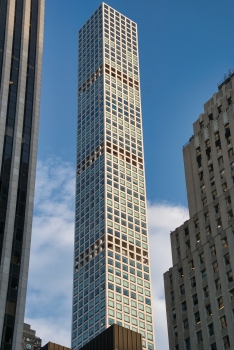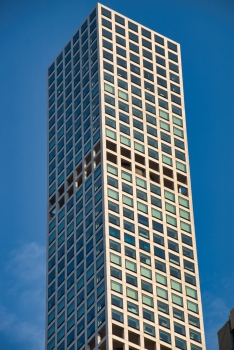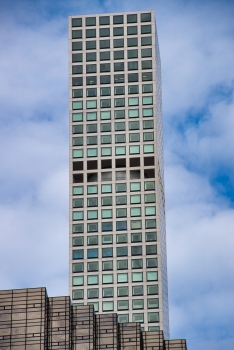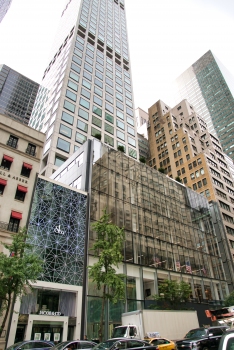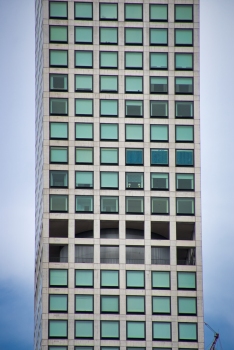General Information
Project Type
| Structure: |
Tube-in-tube structure with outriggers |
|---|---|
| Function / usage: |
Apartment building |
| Material: |
Concrete structure |
Awards and Distinctions
| 2016 |
Award of Excellence
for registered users |
|---|
Location
| Location: |
Manhattan, New York, New York, USA |
|---|---|
| Address: | 432 Park Avenue |
| Coordinates: | 40° 45' 41.88" N 73° 58' 18.47" W |
Technical Information
Dimensions
| height | 426.11 m | |
| number of floors (above ground) | 96 |
Case Studies and Applied Products
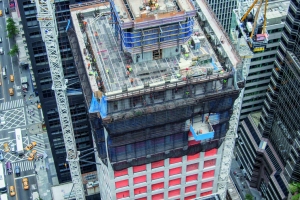
432 Park Avenue, New York: the tallest residential building in the western hemisphere
A new skyscraper is currently under construction in the heart of New York. 432 Park Avenue is to become the tallest residential building in the western hemisphere. Two thirds of the overall building height o ... [more]
Excerpt from Wikipedia
432 Park Avenue is a residential skyscraper in New York City that overlooks Central Park. Originally proposed to be 1,300 feet (396.2 meters) in 2011, the structure topped out at 1,396 ft (425.5 m). It was developed by CIM Group and features 125 condominium apartments. Construction began in 2011 and was completed on December 23, 2015.
The construction was preceded by the demolition of the historic 495-room Drake Hotel and adjacent, typical 19th-century New York townhouses. Built in 1926, the Drake was purchased for $440 million in 2006 (equivalent to $540 million in 2018) by developer Harry Macklowe and razed the next year. Its footprint became one of New York's most valuable development sites due to its location between East 56th and 57th Streets on the west side of Park Avenue.
As completed, 432 Park Avenue is the third-tallest building in the United States and the tallest residential building in the world. It is the second-tallest building in New York City, behind One World Trade Center, and ahead of the Empire State Building. It is also the first, and so far only, building in New York City outside the World Trade Center Complex to be taller than the original Twin Towers.
Height and slenderness
432 Park Avenue officially topped out on October 10, 2014, at 1,398 feet (426 m) making it the second-tallest building in New York City after One World Trade Center and the fifteenth-tallest building in the world. Because much of One World Trade Center's height is in its spire and its base is nearly 40 feet (12 m) lower, the rooftop of 432 Park Ave is, as of 2018, the highest in the city. It surpassed 311 South Wacker as the tallest building in the world known only by its street address.
The tower sits in the middle of the block bounded by East 56th Street, Madison Avenue, East 57th Street, and Park Avenue. The building's 100-foot (30 m) base covers most of the 41,000-square-foot (3,800 m²) lot. The tower is a 93-foot (28 m) square in plan, giving each floorplate an occupiable area of 8,255 square feet (766.9 m²). At 15:1, 432 Park has one of the greatest height-to-width ratios of any skyscraper in the world.
Design
The design of the structure was conceived by architect Rafael Viñoly who was inspired by a trash can designed in 1905 by Austrian designer Josef Hoffmann. The tower has eighty-four 8,255-square-foot (766.9 m²) stories, each with six 100-square-foot (9.3 m²) windows per face. Interiors are designed by Deborah Berke and the firm Bentel & Bentel, which also designed Eleven Madison Park and the Gramercy Tavern. Berke's design brief was simply “no set budget, make it look fantastic”. To support its thin orthogonal frame, the structure features larger columns at its base than on the upper floors.
Apartments and amenities
The tower's condominium units feature high ceilings, and range from a 351-square-foot (32.6 m²) studio to a 8,255-square-foot (766.9 m²), six-bedroom, seven-bath penthouse with a library, which sold for $95 million to real estate mogul Fawaz Alhokair. The building's amenities include 12-foot (3.7 m) ceilings, golf training facilities and private dining and screening rooms.
The first sale of apartment #35B was reported in January 2016 for $18.116 million, more than the $17.75 million asking price. Ten additional apartments were available at the time ranging from $17.4 to $44.25 million. #35B covers 4,000 square feet (370 m²), one half of the 35th floor of the tower, and contains three bedrooms and four-and-a-half baths. Each face has six 10 by 10 ft (3.0 by 3.0 m) windows, which for #35B, face south and west with views of Central Park.
Engineering
The structure of the tower is composed of a 30-foot (9.1 m) square, reinforced concrete core with 30-inch-thick (76 cm) walls, which the engineer, Silvian Marcus, describes as "like the backbone of a body." This core houses the elevator shafts and all the building mechanical services. The outer structural skin is composed of a grid of 3 ft 8 in (1.12 m) wide columns and equal width spandrel (horizontal, exterior) beams of reinforced concrete that encloses the symmetric "basket grid" of window openings. The columns begin with a depth of 5 ft 4 in (1.63 m) at the bottom of the tower, to as little as 20 in (51 cm) at the top. This layout permits all of the interior space on each floor to remain fully open for the complete 27 feet (8.2 m) span between the core and shell.
The façade, with the formed surface left as the final finish without any added facia, was poured in place from concrete using 14,000 psi white Portland cement, and cast around preassembled full-floor cages of #20 rebars with articulated steel formwork. The floor-to-floor height of each of the 85 stories is 15 ft 6 in (4.72 m), with 10 in (25 cm) thick floor slabs, although to damp the acceleration from wind loads, upper floors have slabs up to 18 in (46 cm) thick to add more mass. Also aimed at reducing the potentially uncomfortable effects of swaying due to wind vortex loading on such a flexible tower, the window grid and interior space of 2 floors between every 12 occupied floors are left open to allow the wind to pass through. These floors also contain modularized mechanical services for the six floors above and below to reduce ductwork. In addition two tuned mass dampers are located at the top of the tower and in the outriggers of some of the mechanical floors to help damp the motion.
Ownership
By the end of 2015, close to 90% of the apartments had been sold, with almost every other owner being a foreign citizen, "part of a global elite that collects residences like art." It has been estimated that the majority of the units will remain unoccupied for more than ten months a year.
Some notable residents include Bennett LeBow, Gerard Guez, David Chu, Rene Dahdah, Jennifer Lopez, Stefan Aschbacher, and Alex Rodriguez.
Reception
The skyscraper has received mixed reviews from both professionals and the public alike. Not everyone agreed with the artistic value of the building. Some city residents have criticized 432 Park Avenue, stating that it represents New York's increasing cost of living and ostentatious wealth. 432 Park's association to wealth inequality was also remarked upon by the building's architect himself, Rafael Viñoly, who commented that "There are only two markets, ultraluxury and subsidized housing." Other critics noted 432 Park's slenderness and simplicity. For example, fashion consultant Tim Gunn described the building as "just a thin column. It needs a little cap." The architecture critic for New York magazine, Justin Davidson, wrote that the building is nothing more than just "stacked cubbyhole units" and questioned the creative value of the building.
Text imported from Wikipedia article "432 Park Avenue" and modified on 23 July 2019 under the CC-BY-SA 3.0 license.
Participants
Relevant Web Sites
Relevant Publications
- (2016): Tubed Mega Frame Structural Systems for Tall Buildings. Presented at: IABSE Congress: Challenges in Design and Construction of an Innovative and Sustainable Built Environment, Stockholm, Sweden, 21-23 September 2016, pp. 2742-2749.
- About this
data sheet - Structure-ID
20067944 - Published on:
22/10/2015 - Last updated on:
20/10/2019

